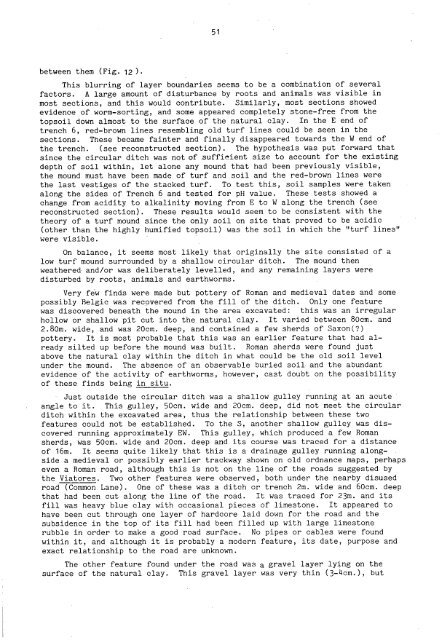Untitled - Council for British Archaeology
Untitled - Council for British Archaeology
Untitled - Council for British Archaeology
- No tags were found...
Create successful ePaper yourself
Turn your PDF publications into a flip-book with our unique Google optimized e-Paper software.
51between them (Fig. 12).This blurring of layer boundaries seems to be a combination of severalfactors. A large amount of disturbance by roots and animals was visible inmost sections, and this would contribute. Similarly, most sections showedevidence of worm-sorting, and some appeared completely stone-free from thetopsoil down almost to the surface of the natural clay. In the E end oftrench 6, red-brown lines resembling old turf lines could be seen in thesections. These became fainter and finally disappeared towards the W end ofthe trench. (see reconstructed section). The hypothesis was put <strong>for</strong>ward thatsince the circular ditch was not of sufficlient size to account <strong>for</strong> the existingdepth of soil within, let alone any mound that had been previously visible,the mound must have been made of turf and soil and the red-brown lines werethe last vestiges of the stacked turf. To test this, soil samples were takenalong the sides of Trench 6 and tested <strong>for</strong> pH value. These tests showed achange from acidity to alkalinity moving from E to W along the trench (seereconstructed section). These results would seem to be consistent with thetheory of a turf mound since the only soil on site that proved to be acidic(other than the highly humified topsoil) was the soil in which the "turf lines"were visible.On balance, it seems most likely that originally the site consisted of alow turf mound surrounded by a shallow circular ditch. The mound thenweathered and/or was deliberately levelled, and any remaining layers weredisturbed by roots, animals and earthworms.Very few finds were made but pottery of Roman and medieval dates and somepossibly Belgic was recovered from the fill of the ditch. Only one featurewas discovered beneath the mound in the area excavated: this was an irregularhollow or shallow pit cut into the natural clay. It varied between 80cm. and2.80m. wide, and was 20cm. deep, and contained a few sherds of Saxon(?)pottery. It is most probable that this was an earlier feature that had alreadysilted up be<strong>for</strong>e the mound was built. Roman sherds were found justabove the natural clay within the ditch in what could be the old soil levelunder the mound. The absence of an observable buried soil and the abundantevidence of the activity of earthworms, however, cast doubt on the possibilityof these finds being in situ.Just outside the circular ditch was a shallow gulley running at an acuteangle to it. This gulley, 50cm. wide and 20cm. deep, did not meet the circularditch within the excavated area, thus the relationship between these twofeatures could not be established. To the S, another shallow gulley was discoveredrunning approximately EW. This gulley, which produced a few Romansherds, was 50cm. wide and 20cm. deep and its course was traced <strong>for</strong> a distanceof 16m. It seems quite likely that this is a drainage gulley running alongsidea medieval or possibly earlier trackway shown on old ordnance maps, perhapseven a Roman road, although this is not on the line of the roads suggested bythe Viatores. Two other features were observed, both under the nearby disusedroad (Common Lane). One of these was a ditch or trench 2m. wide and 60cm. deepthat had been cut along the line of the road. It was traced <strong>for</strong> 23m, and itsfill was heavy blue clay with occasional pieces of limestone. It appeared tohave been cut through one layer of hardcore laid down <strong>for</strong> the road and thesubsidence in the top of its fill had been filled up with large limestonerubble in order to make a good road surface. No pipes or cables were foundwithin it, and although it is probably a modern feature, its date, purpose andexact relationship to the road are unknown.The other feature found under the road was a gravel layer lying on thesurface of the natural clay. This gravel layer was very thin (3-4cm.), but
















